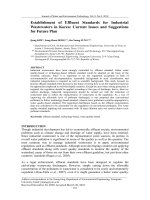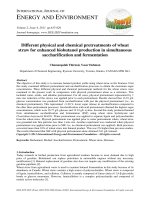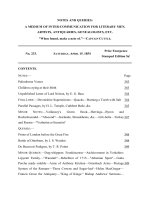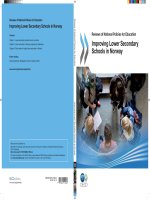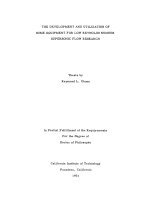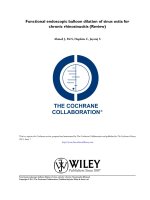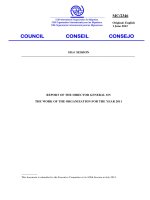Hydroelasticity of VLFS allowances for flexible connectors, gill cells, arbitrary shapes and stochastic waves
Bạn đang xem bản rút gọn của tài liệu. Xem và tải ngay bản đầy đủ của tài liệu tại đây (5.99 MB, 224 trang )
HYDROELASTICITY OF VLFS: ALLOWANCES FOR
FLEXIBLE CONNECTORS, GILL CELLS, ARBITRARY
SHAPES AND STOCHASTIC WAVES
GAO RUIPING
NATIONAL UNIVERSITY OF SINGAPORE
2012
HYDROELASTICITY OF VLFS: ALLOWANCES FOR
FLEXIBLE CONNECTORS, GILL CELLS, ARBITRARY
SHAPES AND STOCHASTIC WAVES
GAO RUIPING
(M.Eng., B.Eng., Southeast University, China)
A THESIS SUBMITTED
FOR THE DEGREE OF DOCTOR OF PHILOSOPHY
DEPARTMENT OF CIVIL AND ENVIRONMENTAL
ENGINEERING
NATIONAL UNIVERSITY OF SINGAPORE
2012
DECLARATION
I hereby declare that the thesis is my original work and it has been written by me
in its entirety.
I have duly acknowledged all the sources of information which have been used in
the thesis.
This thesis has also not been submitted for any degree in any university
previously.
GAO RUIPING
30 October 2012
Acknowledgements
i
Acknowledgements
This thesis is a result of four years of research work at the Department of Civil and
Environmental Engineering of the National University of Singapore.
First of all, my greatest thanks go to my supervisor Professor Wang Chien Ming,
for his ideas, inspiration, advice, constant enthusiasm and interest, and continuous
support on my research work. His immense knowledge nourished my intellectual
maturity that I will benefit from in my life. I feel really happy to work with such an
outstanding researcher as a supervisor.
Also, I would like to thank my supervisor Professor Koh Chan Ghee for the
guidance, valuable advices, discussions, and comments on my research work.
Professor Koh teaches me to think out of the box and always look at the ‘big picture’
which saved me from confusion and doubts in research and in my life.
I am grateful to all my friends and colleagues for their support and encouragement.
Special thanks to Dr. Tay Zhi Yung for his help and valuable suggestions in my
research study.
I would also like to thank Dr. Iason Papaioannou for his collaboration during my
visit to the Chair of Computing in Engineering of the Technische Universität München.
The few months that I spent in Munich were very fruitful in my research work on
stochastic hydroelastic analysis. I would like to thank Professor Ernst Rank, Dr. Ralf-
Peter Mundani, and Professor Wang Chien Ming, who made this visit possible.
Acknowledgements
ii
I am grateful to the National University of Singapore for providing the
scholarship that enabled me to read my PhD degree programme in Singapore.
Finally, I would like to thank my family for their immense love and support.
Table of contents
iii
Table of contents
Acknowledgements i
Table of contents iii
Summary vii
List of tables xi
List of figures xiii
List of notations xix
Chapter 1 Introduction 1
1.1 Very Large Floating Structures 1
1.1.1 Definition of VLFS 3
1.1.2 Applications of VLFS 4
1.2 Literature review 9
1.2.1 Background on hydroelastic analysis of VLFS
9
1.2.2 Modeling of VLFS for hydroelastic analysis 10
1.2.3 Ways for reducing hydroelastic response of VLFS 12
1.2.4 Hydroelastic analysis of VLFS under stochastic waves 22
1.3 Objectives of research study 23
1.4 Layout of thesis 25
Chapter 2 Hydroelastic analysis in frequency domain 27
2.1 Water–plate model 27
2.2 Mathematical formulation 28
Table of contents
iv
2.2.1 Equations of motion for the floating plate 29
2.2.2 Reduction to a single frequency problem 31
2.2.3 Equations of motion for water 32
2.3 Finite element method for solving floating plate motion 34
2.4 Boundary element method for solving fluid motion 39
2.4.1 Constant panel method 41
2.4.2 Higher order boundary element method 44
2.5 Method of decoupling and solutions 50
2.5.1 Modal expansion method 53
2.5.2 Direct method 58
2.6 Stress resultants of plate, and deflection response parameter 59
2.7 Summary 60
Chapter 3 Hydroelastic behavior of VLFS with flexible connector system 63
3.1 Numerical model 63
3.2 Verification of numerical model 66
3.3 Floating plate with one flexible line connector system 71
3.3.1 Effect of connector stiffness and connector location
71
3.3.2 Effect of wave angle 74
3.3.3 Effect of water depth 80
3.3.4 Effect of aspect ratio 82
3.4 Floating plate with multiple flexible line connectors system 84
3.5 Concluding remarks 89
Chapter 4 Hydroelastic behavior of VLFS w
ith hybrid system 91
4.1 Introduction 91
4.2 Numerical model 92
4.3 Optimization of layouts of gill cells 94
4.4 Results and discussion 99
Table of contents
v
4.4.1 Determination of percentages of gill cells 100
4.4.2 Effectiveness of gill cells in reducing hydroelastic response 101
4.4.3 Optimal position of hinge connector and distribution of gill cells
for maximum reduction in hydroelastic response 105
4.4.4 Effect of incident wave angles 108
4.5 Concluding remarks 112
Chapter 5 Hydroelastic analysis of VLFS with arbitrary shapes 113
5.1 Introduction 113
5.2 Numerical model 114
5.3 Verification of numerical model 115
5.3.1 Longish VLFS 115
5.3.2 Circular VLFS 117
5.4 Results and discussion 119
5.4.1 Longish continuous VLFS 119
5.4.2 Longish interconnected VLFS 123
5.4.3 Polygonal VLFS 125
5.5 Concluding remarks 130
Chapter 6 Stochastic hydroelastic analysis of VLFS 133
6.1 Introduction 133
6.2 Numerical model 134
6.3 Stochastic formulation 135
6.3.1 Directional wave spectrum 135
6.3.2 Stochastic response 137
6.3.3 Response of stress resultants 139
6.3.4 Extreme value prediction 142
6.4 Results and discussion 144
6.4.1 Stochastic response 145
6.4.2 Response of stress resultants 148
Table of contents
vi
6.4.3 Extreme value prediction 152
6.5 Concluding remarks 154
Chapter 7 Conclusions and recommendations 155
7.1 Conclusions 155
7.2 Recommendations 158
References 161
List of author’s publications 175
Appendix A FINITE ELEMENT FORMULATION 177
Appendix B BOUNDARY INTEGRAL EQUATION 189
Summary
vii
Summary
Very large floating structure (VLFS) technology allows the creation of land from the
sea without the need for massive amount of fill materials and with little disturbance to
the current flow and water quality. VLFSs have been gradually appearing in many
parts of the world for a wide range of applications, such as floating bridges, floating
piers, floating performance stages, and floating oil storage facilities. Owing to their
much larger dimensions in length than in depth, VLFSs are relatively flexible and thus
they have to be robustly designed against wave-induced deformations and stresses,
especially for applications that demands stringent serviceability requirements. Owing
to their attractive appearance and better wave attenuation capability, irregular shaped
VLFSs are becoming popular and thus more efforts should be made to better
understand their hydroelastic behavior under wave action. In addition, a reliability
analysis of VLFSs has to be carried out that allow for both the modeling of uncertain
behavior and the handling of the computational complexity.
This thesis focuses on the hydroelastic analysis of VLFSs, i.e. the study of the
response of floating structures to surface water waves. The main objectives of this
study are to study ways to mitigate the hydroelastic response of VLFSs so as to
improve its serviceability performance and also to advance the hydroelastic analysis
under random water waves. In this study, the considered ways in reducing hydroelastic
response of VLFSs are the use of flexible connectors, gill cells and appropriate shapes.
Summary
viii
For the hydroelastic analysis, the VLFS is modeled as a giant floating plate. The
Mindlin (or first order shear deformable) plate theory is adopted for a more accurate
prediction of the plate deflections and stress resultants since the theory includes the
effect of transverse shear deformation and rotary inertia. Moreover, the Mindlin plate
theory expresses the stress-resultants as first derivatives of the bending rotation and
deflection instead of second and third derivatives of the deflections as in the classical
thin plate theory. The water is modeled as an ideal fluid and its motion is assumed to
be irrotational so that a velocity potential exists. In solving the coupled water–plate
interaction problem, two methods are adopted for the hydroelastic analysis (performed
in the frequency domain), namely, the modal expansion method and the direct method.
The finite element method is used to solve the deflection of the floating plate, whereas
the boundary element method is adopted for solving the Laplace equation (which is the
governing equation for fluid motion) together with the fluid boundary conditions for
the velocity potential. Both the constant panel method and the higher order boundary
element method are adopted for solving the water potential.
The background, introduction, and literature review on hydroelastic analysis of
VLFSs are given in Chapter 1. Chapter 2 describes the general theory, the basic
equations of motion of fluid and VLFS, formulations and solutions of a water–plate
interaction problem. Chapter 3 investigates the hydroelastic response of very large
floating structures with a flexible connector system and to study the effectiveness of
such a system in reducing the hydroelastic response as well as the stress resultants of
the floating plate. Flexible line connections are found to be effective in reducing the
hydroelastic response of the considered VLFSs provided that they are appropriately
placed. For a greater reduction in the hydroelastic response, a novel hybrid system that
comprises the use of flexible connector and gill cells are investigated in Chapter 4. Gill
Summary
ix
cells are compartments in VLFS that allow free passage of water. It is found that a
significant reduction in both the hydroelastic response and the stress resultants of the
studied VLFS can be achieved with the combined presence of a suitably positioned
flexible line connector and an appropriate distribution of gill cells. Chapter 5 extends
an existing higher order boundary element method for hydroelastic analysis of VLFSs
with arbitrary shapes. The shaping of the front edges and end edges of longish VLFS is
explored with the view to reduce the hydroelastic response of VLFS. Both the
hydroelastic response and stress resultants can be effectively reduced by having
appropriate end shapes in the studied VLFSs. Based on the linear random vibration
theory, Chapter 6 proposes a framework for stochastic hydroelastic analysis of VLFS
considering a directional wave spectrum. The hydroelastic behaviour of the example
VLFS is found to be greatly affected when considering a directional wave spectrum in
which the effect of oblique wave is integrated. The conclusions of present studies and
recommendations for future studies are presented in Chapter 7.
The studies carried out in the thesis provide new ideas in mitigating the
hydroelastic response of VLFSs. The extended higher order boundary element method
can be applied to predict the hydroelastic response of floating plates with arbitrary
shape. The proposed framework of stochastic hydroelastic analysis may be adopted for
reliability assessment of VLFSs. The results reported herein would be useful
information to offshore and marine engineers working on VLFSs.
List of tables
xi
List of tables
Table 3.1 Parameters of Fu et al. (2007) floating plate problem
67
Table 3.2 Comparison of natural frequencies obtained by present study and Fu et al.
(2007) 67
Table 5.1 Parameters of ISSC VLFS benchmark (Riggs et al., 2008) 116
Table 5.2 Parameters of circular VLFS considered 118
List of figures
xiii
List of figures
Figure 1.1 Mega Float in Tokyo Bay, Japan 5
Figure 1.2 Kamigoto oil storage facility in Nagasaki, Japan 5
Figure 1.3 Shirashima oil storage facility in Kitakyusyu, Japan.
6
Figure 1.4 Floating bridge, Dubai 6
Figure 1.5 Floating performance stage at Marina Bay, Singapore. 7
Figure 1.6 Lilypad Floating Ecopolis. 8
Figure 1.7 Floating town in the Netherlands. 8
Figure 1.8 Floating convention centre in Maldives. 9
Figure 1.9 Breakwater system: (a) bottom-founded type, (b) floating type, and (c)
oscillating-water-column type 13
Figure 1.10 Vertical elastic connector.
14
Figure 1.11 Air cushions supported VLFS proposed by (a) P
inkster et al. (1997), (b)
Pinkster and Meevers Scholte (2001), (c) Van Kessel (2008), and (d)
Ikoma et al. (2008, 2009) 15
Figure 1.12 Submerged anti-motion devices (a) subm
erged vertical plate (Ohta et al.,
1999), (b) submerged horizontal plate (Ohta et al., 1999; Utsunomiya et al.,
2000), (c) box-shaped devices (Takagi et al., 2000), (d) submerged
inclined plate (Takaki and Nishikawa, 2001), (e) vertical plate with slits
(Masanobu et al., 2003), and (f) inverted-L shaped structure (Masanobu et
al., 2003). 17
Figure 1.13 Various VLFS shapes studied by (a) Ha
mamoto and Fujita (2002), (b)
Andrianov and Hermans (2006), (c) Xu and Lu (2011), and (d) Okada
(1998). 21
List of figures
xiv
Figure 2.1 Schematic diagram of coupled water–plate problem: (a) plan view and (b)
elevation view 28
Figure 2.2 8-node isoparametric Mindlin plate element: (a) physical element and (b)
master element 36
Figure 2.3 Flow chart for solving water–plate problem using modal expansion method.
51
Figure 2.4 Flow chart for solving water–plate problem using direct method. 52
Figure 3.1 Rectangular VLFS with one flexible line connector: (a) plan view and (b)
elevation view 64
Figure 3.2 Two Mindlin plate elements connected by a flexible line connector. 66
Figure 3.3 Hydroelastic responses along the longitudinal centerline of VLFS for (a)
= 0.2 (b)
= 0.4 (c)
0.6
(d)
0.8
and (e)
1.0
. Location of
connector 5.0
. Head sea wave condition. 69
Figure 3.4 Bending moment
x
x
M
along the longitudinal centerline of floating plate for
= 0.48 and
= 0.5. Head sea wave condition 70
Figure 3.5 Comparison between Mindlin shear force
x
Q and Kirchhoff effective shear
force
x
V along longitudinal centerline of floating plate for
= 0.48 and
= 0.5. Head sea wave condition 70
Figure 3.6 Variations of normalized deflection parameter /
with respect to
and
r
for (a) 0.1
(b) 0.2
(c) 0.3
and (d) 0.4
. Head sea
wave condition 0
.
opt
is the optimal location that gives minimum
value of
and it is corresponding to different wavelength-to-structure
length ratio cases. Note that the VLFS is of length L = 300m, width B =
60m and height h = 2m 73
Figure 3.7 Hydroelastic response along the longitudinal centerline of VLFS with
di
fferent rotational stiffness coefficient
r
under head sea wave condition.
0.26
and 0.1
74
Figure 3.8 Variations of deflection param
eter
with respect to wave angle
and the
optimal location
opt
corresponds to minimum
at different wave angles
for (a)
0.1
(b) 0.2
(c) 0.3
and (d) 0.4
. No values for
opt
denotes that the plate has a rigid connection (i.e. the plate is continuous).77
Figure 3.9 Deflections of the rigidly connected (continuous) VLFS subjected to
0.2
for various wave angles 78
List of figures
xv
Figure 3.10 Deflection amplitude, bending m
oment, and shear forces along the
longitudinal centerline of the VLFS with optimum
for (a) 0.1
and
(b)
0.2
subjected to head sea condition
0
79
Figure 3.11 Deflections of the rigidly connected (continuous) and hinge connected
(with optim
um
) VLFS for (a) 0.1
(b) 0.2
(c) 3.0
and (d)
0.4
. Head sea condition 0
81
Figure 3.12 Variations of deflection param
eter
with respect to aspect ratio B/L and
the optimal location
opt
corresponds to minimum
at different aspect
ratios for (a)
0.1
(b) 0.2
(c) 0.3
and (d) 0.4
. Head sea
condition
0
. L = 300m 83
Figure 3.13 Deflections along the longitudinal centerline of VLFS having different
aspect ratios with optim
um
opt
for (a) 0.2
and (b) 0.4
subjected
to head sea condition
0
. 84
Figure 3.14 Rectangular VLFS with multiple flexible line co
nnectors. 85
Figure 3.15 Hydroelastic response along the longitudinal centerline of VLFS with
optim
um
for 0.1
, 0.2
, 0.3
, and 0.4
subjected to head
sea wave condition
0
. No values for
opt
denotes that the plate has a
rigid connection (i.e. the plate is continuous). 87
Figure 3.16 Bending moment (a) and shear forces (b) along the longitudinal centerline
of
VLFS with optimum
for 0.1
, 0.2
, 0.3
, and 0.4
subjected to head sea wave condition
0
88
Figure 4.1 Rectangular VLFS with a flexible lin
e connector and gill cells: (a) plan
view and (b) elevation view. 93
Figure 4.2 Transformation of binary string to matrix representation of VLFS with gill
cells.
97
Figure 4.3 Center of mass of initial individuals 98
Figure 4.4 Optimization program flowchart integrating constrained GA and current
model.
99
Figure 4.5 Static displacements along longitudinal centerline of floating plate with
various percentages of gill cells.
100
Figure 4.6 Optimal layouts of gill cells for rigid
ly connected (first row) and hinge
connected (second row) VLFS subjected to head sea wave. The hinge
connection is placed at
0.26
for
= 30 m case and 0.34
for
=
60 m case 102
List of figures
xvi
Figure 4.7 Response amplitude, nondimensionalized bending moments and shear
forces along
longitudinal centerline of VLFS subjected to head sea wave
condition
= 0°. (a)
= 30 m and (b)
= 60 m. Note that the
configurations of VLFS shown in Fig. 4.6 are used 103
Figure 4.8 Deflection parameter values for VLFS with var
ious rotational stiffness
parameters. 104
Figure 4.9 Response amplitude along the long
itudinal centerline of VLFS having
different rotational stiffness. (a)
= 30 m and (b)
= 60 m. Note that the
configurations of the VLFS shown in the second row of Fig. 4.6 are used.
104
Figure 4.10 Normalized deflection parameter results for four configurations of VLFS.
(a)
= 30 m and (b)
= 60 m. 106
Figure 4.11 Optimal configurations of gill cells layout and hin
ge connector position for
VLFS subjected to head sea wave
= 0°. (a)
= 30 m and (b)
= 60 m.
106
Figure 4.12 Response amplitudes, nondimensionalized bend
ing moments and shear
forces along the longitudinal centerline of VLFS subjected to head sea
wave condition
= 0°. (a)
= 30 m and (b)
= 60 m. Note that the
configurations shown in Fig. 4.11 are used for VLFS having hinge
connection and gill cells 107
Figure 4.13 Hydroelastic response of rigidly connected VLFS without gill cells (A)
and VLFS with the configurations shown in Fig. 4.11 (B) subjected to head
sea wave
0
. (a)
= 30 m and (b)
= 60 m. 108
Figure 4.14 Deflection parameter results of VLFS subjected to various wave angles.
opt
is associated with the minimum value of deflection parameter
. (a)
= 30 m and (b)
= 60 m. 110
Figure 4.15 Optimal configurations of gill cells layout and hin
ge connector position for
VLFS subjected to an oblique wave
θ = 45°. (a)
= 30 m and (b)
= 60
m 110
Figure 4.16 Deflection parameter
results of VLFS with different configurations
subjected to various incident wave angles. (a)
= 30 m and (b)
= 60 m.
110
Figure 4.17 Hydroelastic response of rigidly connected VLFS without gill cells (A)
and VLFS with the configurations shown in Fig. 4.15 (B) subjected to an
oblique wave
45
. (a)
= 30 m and (b)
= 60 m. 111
Figure 4.18 Hydroelastic response of rigidly connected VLFS without gill cells (A)
and VLFS with the configurations shown in Fig. 4.11 (B) subjected to an
oblique wave
15
. (a)
= 30 m and (b)
= 60 m 111
List of figures
xvii
Figure 5.1 Arbitrary shaped VLFS: (a) plan v
iew and (b) elevation view. 114
Figure 5.2 Deflection amplitude along the centerline of the ISSC VLFS benchmark for
(a)
0
and (b)
45
. 117
Figure 5.3 Geometry of a uniform circular VLFS and coordin
ate system. 118
Figure 5.4 Deflection amplitude along the cen
terline of a circular VLFS 118
Figure 5.5 Longish VLFS with various fore- and aft-ends shapes. 120
Figure 5.6 Deflection amplitude, bending moments and shear forces along the
longitud
inal centerline of VLFS subjected to head sea wave condition
=
0°. (a)
= 30 m and (b)
= 60 m. 121
Figure 5.7 Deflection parameter
values of VLFS with different fore/aft ends
subjected to different incident wave angles. (a)
= 30 m and (b)
= 60
m 122
Figure 5.8 Deflection amplitude along the long
itudinal centerline of interconnected
VLFS with different fore ends. (a)
= 30 m and (b)
= 60 m. 124
Figure 5.9 A series of polygonal shaped VLFS ge
nerated by Eq. (5.1). The numbers
between brackets refer to (
n
1
; n
2
= n
3
; a = b). m is the number of rotational
symmetries. (a) Zerogon (100; 100; 75.7), (b) Monogon (20; 100; 2.009),
(c) Diagon (100; 100; 67.1), (d) Triangle (54; 100; 9.08), (e) Square (100;
100; 67.1), (f) Pentagon (150; 100; 586), (g) Hexagon (2.5; 1; 6.29×10
4
),
(h) Octagon (3.5; 1; 4.77×10
6
), (i) Decagon (7.0; 1; 1.8×10
13
). 126
Figure 5.10 Deflection parameter
values of VLFS with various shapes indicated by
their rotational symmetries
m for (a)
= 30 m and (b)
= 60 m. 128
Figure 5.11 Hydroelastic response of triangular VLFS (
m = 3) and square VLFS (m = 4)
under
= 60 m for two wave angles. (a) 0
and (b) / m
. 129
Figure 5.12 Hydroelastic response of circular VL
FS and diagon VLFS. (a)
= 30 m
and (b)
= 60 m. 130
Figure 6.1 Schematic diagram of a coupled water–plate m
odel: (a) plan view and (b)
elevation view. 134
Figure 6.2 Mesh of the plate. 145
Figure 6.3 Plot of the applied directional wave spectrum for
0
145
Figure 6.4 Input spectrum
BM
S and response spectra of the vertical displacements at 5
selected points for different mean wave angles. 147
Figure 6.5 Standard deviations of the vertical d
isplacements for different mean wave
angles. 148
List of figures
xviii
Figure 6.6 Standard deviation of
x
x
M
for different mean wave angles 150
Figure 6.7 Standard deviation of
yy
M
for different mean wave angles 150
Figure 6.8 Standard deviation of
x
y
M
for different mean wave angles 151
Figure 6.9 Standard deviation of
x
Q for different mean wave angles. 151
Figure 6.10 Standard deviation of
y
Q for different mean wave angles 152
Figure 6.11 Expected maximum of response quantities predicted by the Vanm
arcke
approximation for a 2 hours period for
0
. 153
Figure 6.12 Maximum value of extremes of stres
s resultants in terms of the mean wave
angle. 153
List of notations
xix
List of notations
A
Wave amplitude, m
B
Plate width, m
g
c
Percentage of gill cells used in the VLFS compartments
D
Plate flexural rigidity, Nm
E
Young’s modulus, N/m
2
g
Gravitational acceleration, 9.81 m/s
2
G
Shear modulus, N/m
2
h
Plate thickness, m
H
Water depth, m
k
Wave number, m
-1
r
k
Rotational spring stiffness of the connection, Nm/rad
w
k
Constant of hydrostatic stiffness
L
Plate length, m
,;
nn ns n
M
MQ
Bending and twisting moment, MN·m/m; shear force, kN/m
c
n
Number of flexible line connectors
N
Number of modes considered in the modal expansion method
p
Number of plate elements in the mesh
